
A threshing machine or a thresher is a piece of farm equipment that separates grain seed from the stalks and husks. It does so by beating the plant to make the seeds fall out. Before such machines were developed, threshing was done by hand with flails: such hand threshing was very laborious and time-consuming, taking about one-quarter of agricultural labour by the 18th century. Mechanization of this process removed a substantial amount of drudgery from farm labour. The first threshing machine was invented circa 1786 by the Scottish engineer Andrew Meikle, and the subsequent adoption of such machines was one of the earlier examples of the mechanization of agriculture. During the 19th century, threshers and mechanical reapers and reaper-binders gradually became widespread and made grain production much less laborious.

Cyrus Hall McCormick was an American inventor and businessman who founded the McCormick Harvesting Machine Company, which later became part of the International Harvester Company in 1902. Originally from the Blue Ridge Mountains of Virginia, he and many members of the McCormick family became prominent residents of Chicago. McCormick has been simplistically credited as the single inventor of the mechanical reaper. He was, however, one of several designing engineers who produced successful models in the 1830s. His efforts built on more than two decades of work by his father Robert McCormick Jr., with the aid of Jo Anderson, a slave owned by the family. He also successfully developed a modern company, with manufacturing, marketing, and a sales force to market his products.

The modern combine harvester, or simply combine, is a machine designed to harvest a variety of grain crops. The name derives from its combining four separate harvesting operations—reaping, threshing, gathering, and winnowing—to a single process. Among the crops harvested with a combine are wheat, rice, oats, rye, barley, corn (maize), sorghum, millet, soybeans, flax (linseed), sunflowers and rapeseed. The separated straw, left lying on the field, comprises the stems and any remaining leaves of the crop with limited nutrients left in it: the straw is then either chopped, spread on the field and ploughed back in or baled for bedding and limited-feed for livestock.

LaMarcus Adna Thompson was an American inventor and businessman most famous for developing a variety of gravity rides and roller coasters.

A reaper is a farm implement or person that reaps crops at harvest when they are ripe. Usually the crop involved is a cereal grass. The first documented reaping machines were Gallic reapers that were used in Roman times in what would become modern-day France. The Gallic reaper involved a comb which collected the heads, with an operator knocking the grain into a box for later threshing.
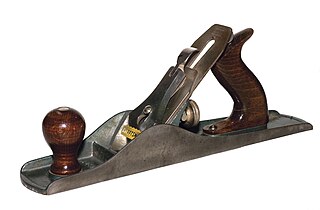
A hand plane is a tool for shaping wood using muscle power to force the cutting blade over the wood surface. Some rotary power planers are motorized power tools used for the same types of larger tasks, but are unsuitable for fine-scale planing, where a miniature hand plane is used.

An inclined plane is a type of cable railway used on some canals for raising boats between different water levels. Boats may be conveyed afloat, in caissons, or may be carried in cradles or slings.

The reaper-binder, or binder, is a farm implement that improved upon the simple reaper. The binder was invented in 1872 by Charles Baxter Withington, a jeweler from Janesville, Wisconsin. In addition to cutting the small-grain crop, a binder also 'binds' the stems into bundles or sheaves. These sheaves are usually then 'shocked' into A-shaped conical stooks, resembling small tipis, to allow the grain to dry for several days before being picked up and threshed.
Improvements to the steam engine were some of the most important technologies of the Industrial Revolution, although steam did not replace water power in importance in Britain until after the Industrial Revolution. From Englishman Thomas Newcomen's atmospheric engine, of 1712, through major developments by Scottish inventor and mechanical engineer James Watt, the steam engine began to be used in many industrial settings, not just in mining, where the first engines had been used to pump water from deep workings. Early mills had run successfully with water power, but by using a steam engine a factory could be located anywhere, not just close to a water source. Water power varied with the seasons and was not always available.

William Bullock was an American inventor whose 1863 improvements to Richard March Hoe's rotary printing press helped revolutionize the printing industry due to its great speed and efficiency. A few years after his invention, Bullock was accidentally killed by his own web rotary press.
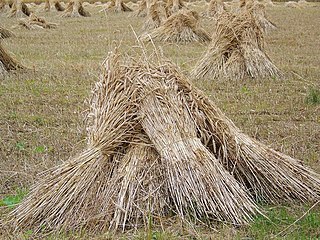
A stook /stʊk/, also referred to as a shock or stack, is an arrangement of sheaves of cut grain-stalks placed so as to keep the grain-heads off the ground while still in the field and before collection for threshing. Stooked grain sheaves are typically wheat, barley and oats. In the era before combine harvesters and powered grain driers, stooking was necessary to dry the grain for a period of days to weeks before threshing, to achieve a moisture level low enough for storage. In the 21st century, most grain is produced with the mechanized and powered methods, and is therefore not stooked at all. However, stooking remains useful to smallholders who grow their own grain, or at least some of it, as opposed to buying it.

Obed Hussey (1792–1860) was an American inventor. His most notable invention was a reaping machine, patented in 1833, that was a rival of a similar machine, patented in 1834, produced by Cyrus McCormick. Hussey also invented a steam plow, a machine for grinding out hooks and eyes, a mill for grinding corn and cobs, a husking machine, a machine for crushing sugar cane, a machine for making artificial ice, a candle-making machine, and other devices. However, he devoted the prime of his life to perfecting his reaping machine.
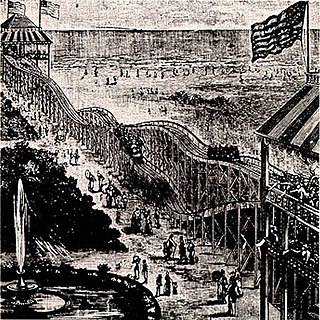
The original Switchback Railway was the first roller coaster at Coney Island in Brooklyn, New York City, and one of the earliest designed for amusement in the United States. The 1885 patent states the invention relates to the gravity double track switchback railway, which had predicated the inclined plane railway, patented in 1878 by Richard Knudsen. Coney Island's version was designed by LaMarcus Adna Thompson in 1881 and constructed in 1884. It appears Thompson based his design, at least in part, on the Mauch Chunk Switchback Railway which was a coal-mining train that had started carrying passengers as a thrill ride in 1827.
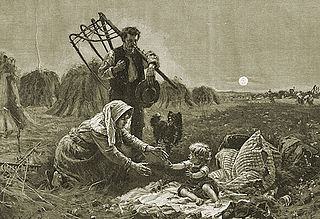
A grain cradle or cradle, is a modification to a standard scythe to keep the cut grain stems aligned. The cradle scythe has an additional arrangement of fingers attached to the snaith to catch the cut grain so that it can be cleanly laid down in a row with the grain heads aligned for collection and efficient threshing.

The Oliver Farm Equipment Company was an American farm equipment manufacturer from the 20th century. It was formed as a result of a 1929 merger of four companies: the American Seeding Machine Company of Richmond, Indiana; Oliver Chilled Plow Works of South Bend, Indiana; Hart-Parr Tractor Company of Charles City, Iowa; and Nichols and Shepard Company of Battle Creek, Michigan.
John Francis Appleby (1840–1917) was an American inventor who developed a knotting device to bind grain bundles with twine. It became the foundation for all farm grain binding machinery and was used extensively by all the major manufacturers of large grain harvesting machines in the late 19th and early 20th centuries. Appleby's knotting device was a major landmark in the mechanization of agriculture and aided the development of the western wheat fields of the United States.

John Henry Manny (1825–1856) was the inventor of the Manny Reaper, one of various makes of reaper used to harvest grain in the 19th century. Cyrus McCormick III, in his Century of the Reaper, called Manny "the most brilliant and successful of all Cyrus McCormick's competitors," a field of many brilliant people.

Abraham Lincoln's patent relates to an invention to buoy and lift boats over shoals and obstructions in a river. Abraham Lincoln conceived the invention when on two occasions the boat on which he traveled got hung up on obstructions. Lincoln's device was composed of large bellows attached to the sides of a boat that were expandable due to air chambers. Filed on March 10, 1849, Lincoln's patent was issued as Patent No. 6,469 later that year, on May 22. His successful patent application led to his drafting and delivering two lectures on the subject of patents while he was president.
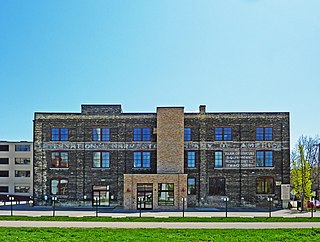
The McCormick–International Harvester Company Branch House was built in 1898 in Madison, Wisconsin as a distribution center for farm implements of the McCormick Harvesting Machine Company. After McCormick merged into the International Harvester Company in 1902, the building was expanded and served the same function for the new company. In 2010 it was added to the National Register of Historic Places.

A sheaf is a bunch of cereal-crop stems bound together after reaping, traditionally by sickle, later by scythe or, after its introduction in 1872, by a mechanical reaper-binder.

















